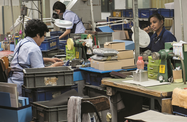
 On meeting rising demand for medical gloves and preparing for long-term industry expansion
On meeting rising demand for medical gloves and preparing for long-term industry expansion
What were the biggest challenges to rapidly scaling up production to meet high global demand for medical gloves created by the Covid-19 pandemic?
LIM WEE CHAI: Prior to the outbreak of Covid-19 we were already expanding our capacity to cater to rising global demand, which was growing at 10% yearly. As such, we were building around one or two new factories each year and had spare capacity that we were able to utilise to ramp up production as demand more than doubled due to the pandemic. Indeed, our production utilisation has increased from 85% to nearly 100%.
At the onset of the lockdown imposed by the Malaysian government to stem the spread of Covid-19, slight disruptions were encountered due to the short timeframe businesses had to prepare, resulting in some temporary delays in the construction of new facilities and logistical problems with some suppliers. However, subsequent approval from the Ministry of International Trade and Industry permitted the supporting industries to operate at 100% capacity. We had also previously established our own latex concentrate plants, chemical factories and packaging materials factories, and this has helped secure our internal supply.
Which export markets have generated the largest growth in demand since the onset of the pandemic?
LIM: Demand for medical gloves has surged globally. The growth in demand started in China and South Korea, where the outbreak first happened, then it followed in Europe and the US as the virus spread. Overall, demand has risen considerably compared to our normal order volume.
How do you expect the Covid-19 pandemic to impact international demand for surgical gloves over the longer term?
LIM: The demand for gloves as an essential item in the health care sector was expected to grow by at least 10% each year, even before the onset of the pandemic. With increased awareness of the importance of gloves arising from the pandemic, people who started using gloves in recent months are expected to continue using them even after the pandemic recedes, further driving demand, which is estimated to grow by 12% per year in the post-Covid-19 environment.
It is also important to recognise that the spike in demand arising from Covid-19 is temporary. Indeed, over the past 30 years we have seen many epidemics and pandemics – including SARS, Swine Flu, H1N1, Bird Flu and Ebola – as they happen about once every five years. Covid-19 is part of this repeating cycle.
Expansion efforts are designed to cater to growing glove demand over the longer term. Our company believes that the market will be able to absorb the additional capacity, and we will continue to expand production and adjust plans if necessary.
Where should the government focus its reforms to be most effective in enabling Malaysia to further capitalise on its position in the global supply chain?
LIM: First and foremost, we need a robust, stable government. This supports a business-friendly environment that attracts both local and foreign investment. Moreover, Malaysia’s corporate tax rate is currently 24%, which places it among the highest in the region; this reduces competitiveness.
There also needs to be a sharper focus on improving the quality of education so that the country is able to produce and retain more local talent which will, in turn, help the country progress further. In addition, we hope to see improved public services with less red tape and smoother, more efficient processes, which will enable businesses to grow faster.
At the same time, it is very encouraging to see the government placing an increased emphasis on combating corruption and we look forward to seeing further efforts in this area, which will boost Malaysia’s appeal as an investment destination.


 On meeting rising demand for medical gloves and preparing for long-term industry expansion
On meeting rising demand for medical gloves and preparing for long-term industry expansion